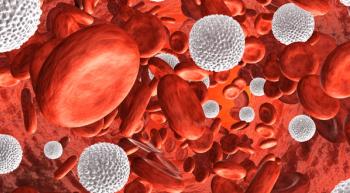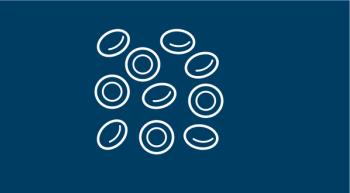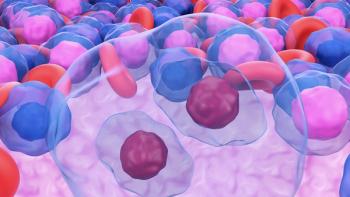
Low-Dose Venetoclax Induces Antitumor Activity in Subsets of AL Amyloidosis, Myeloma
Overall, 71% of patients with AL amyloidosis and 33% of those with heavily pretreated multiple myeloma achieved a partial response or greater after receiving treatment with low dose venetoclax.
Treatment with low-dose venetoclax monotherapy may be effective in reducing tumor activity in patients with heavily pretreated multiple myeloma or light chain (AL) amyloidosis harboring t(11;14), according to data recently published in the American Journal of Hematology. 1
Across the study population (n = 25), 44% of patients (n = 11) experienced a partial response (PR) or higher following treatment with venetoclax. Specifically, 71% of patients with AL amyloidosis and 33% of those with multiple myeloma achieved a PR or greater.
The study was conducted to assess the safety and efficacy of single-agent venetoclax, as well as to determine the importance of molecular markers in predicting treatment response. Additionally, potential resistance mechanisms of patients with multiple myeloma harboring t(11;14) were evaluated.
“We believe this study is a significant step towards multiple myeloma treatment by providing ways for selection of the optimal treatment regimens, prognostic biomarker, [resistance] mechanism, and increased understanding of t(11;14) role in multiple myeloma pathogenesis,” Hareth Nahi, MD, senior physician of Karolinska Institutet in Sweden, and coinvestigators wrote in the paper.
The trial enrolled 18 patients who were diagnosed with relapsed multiple myeloma and 7 with relapsed AL amyloidosis, all of whom harbored t(11;14). All patients who enrolled received a 100-mg dose of daily venetoclax for the first 3 days, with an escalation of 100 mg every third day up to a maximum dose of 400 mg daily.
Of the 25 patients who enrolled, 20 had diagnostic bone marrow biopsies available. Among the patients with available biopsies, 8 relapse bone marrow biopsies were examined. RNA sequencing was performed on 37 samples from patients with newly diagnosed multiple myeloma, 10 of which harbored t(11;14).
“The newly diagnosed multiple myeloma samples were obtained from untreated patients, whereas relapsed/refractory patients received standard multiple myeloma treatments,” the authors wrote.
Three subsets of these samples were selected based on the following criteria: BCL-2 cohort (n = 37; newly diagnosed myeloma), 27 non-t(11;14) vs 10 harboring t(11;14); resistance cohort (n = 12), 8 newly diagnosed myeloma vs 4 relapsed/refractory myeloma and all patients with t[11;14] more than 60%; and synergy cohort (n = 12), 2 hyperdiploidy, 7 harboring t(11;14), and 3 harboring hyperdiploidy and t(11;14).”
Forty percent (n = 10) of the patient population were male and the median age was 57 years old (range, 43-80). Thirty percent (n = 7) of the population had stage III disease. In addition to all patients having t(11;14), all patients with multiple myeloma harbored another aberration.
The median follow-up time from the start of treatment was 9 months. All of these patients were treated with a proteasome inhibitor and 96% were given an immunomodulatory drug prior to receiving venetoclax. The median prior lines of therapy was 3 (range, 1-9).
The median time on treatment was 7.2 months, and those who achieved a PR or better were on venetoclax for at least 15 months, with no median reached, compared with 6 months for those who achieved less than a PR.
Twenty patients received immunohistochemistry from bone marrow from diagnosis and even later relapse in some cases. No significant changes were noted in terms of percentage of CD138-positive multiple myeloma cells expressing anti- and pro-apoptotic proteins from diagnosis to relapse or between patients who achieved greater than or less than a PR. However, it was noted that the frequency of BCL-2– and MCL1-expressing cells across analyzed myeloma samples were notably higher (P = .031), in patients who achieved greater than and less than a PR having an average ratio of 2.7 and 1.0, respectively, following treatment.
Similar data was seen in newly diagnosed myeloma samples (P = .028). Similar trends were noted in patients with relapsed/refractory disease.
“We conclude that these increased BCL-2/MCL1 and BCL-2/BCL2-XL ratios can be used to predict the venetoclax response in addition to presence of t(11;14),” the authors wrote.
Moreover, an RNA-sequencing analysis of the resistance cohort (n = 12) uncovered 46 differentially expressed genes between diagnosis and relapse, 26 of which were downregulated and 20 of which were upregulated. In total, 65% of the downregulated genes contained binding motifs for an IRF transcription family member in the promoter region.
IRFs motif enrichments were calculated in the promoter regions of downregulated differentially expressed genes and the enrichments were hierarchically sorted based on the adjusted P values. Results showed that that the IRF5 motif enrichment ranked the highest [P < .001]. However, IRF5 was not found among the differentially expressed genes,” the authors wrote.
Additionally, investigators correlated the top 3 hierarchically ordered IRFs—IRF5, IRF8, and IRF9—with the expression of 17 differentially expressed genes containing IRF motif; IRF5 ranked at first place.
Although 80% of the study population experienced all-grade treatment-emergent adverse effects, grade 3/4 TEAEs occurred in 52% of patients; all events were considered manageable and no deaths linked with treatment occurred, according to investigators. The most common non-hematologic AE was nausea (32%) with hematologic AEs including neutropenia (28%) and thrombocytopenia (28%).
"The study shows that selection of low dose venetoclax was critical to reduce the [AEs] of the drug without adventuring the benefit of venetoclax in regard to response rates and survival," first author Hareth Nahi, MD, a senior physician and associate professor in the Department of Medicine at the Center for Hematology and Regenerative Medicine, Huddinge, Karolinska Institutet, concluded in a press release.2
References
- Nahi H, Kashif M, Klimkowska M, et al. Low dose venetoclax as a single agent treatment of plasma cell malignancies harboring t(11;14). Am J Hematol. 2021;1-9. doi:10.1002/ajh.26207
- New findings provide hope for treatment of multiple myeloma. News release. Karolinska Institutet. May 19, 2021. Accessed May 27, 2021. https://bit.ly/3yTPCj8
This article was originally published on OncLive as
Newsletter
Knowledge is power. Don’t miss the most recent breakthroughs in cancer care.
















































































